ANOTHER SOLAR ECLIPSE TRIP TO ARGENTINA
2020 December 14, Monday
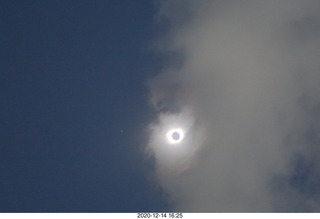 This is the story of my thirteenth total solar eclipse,
a brief travel adventure back to Argentina.
I expected to come home with
pictures
and a few adventure stories.
This is my seventh trip with Brian McGee's companies,
Explorers and then Astro Trails,
and the seventh time I have been deliriously happy
with the results.
Mike was our guide for Tour 1
and I was deliriously happy with his efforts as well.
This is the story of my thirteenth total solar eclipse,
a brief travel adventure back to Argentina.
I expected to come home with
pictures
and a few adventure stories.
This is my seventh trip with Brian McGee's companies,
Explorers and then Astro Trails,
and the seventh time I have been deliriously happy
with the results.
Mike was our guide for Tour 1
and I was deliriously happy with his efforts as well.
This was made far more challenging by COVID-19 restrictions
and I really didn't want to be stuck in a two-week quarantine.
(While I worry about all kinds of travel ailments and illnesses,
dengue and Zika on this trip,
I don't worry especially about COVID-19 itself
for a variety of
reasons.)
Argentina's border has been closed to intercontinental travel
since 2020 March or April
and the total solar eclipse was the reason to change that.
Astro Trails and Brian McGee were amazing
in finding the win-win where we get to go on our trip
and Argentina gets much-needed tourist revenue.
 If this were some other well-recognized tour company,
then I probably wouldn't have taken the chance of getting stuck.
In addition to my confidence in Brian's skills,
there is the notion that I want to show him and his company
how much I believe in them
and how important I feel their mission is.
We have to buy from vendors whose products we cherish
lest they vanish and we're left without them.
Excellence is always dear and must be supported.
(That having been said, all my usual eclipse friends decided not
to go on this trip, some to avoid quarantines and some for health,
and I respect and agree with their reasons.
My decision was to go.)
If this were some other well-recognized tour company,
then I probably wouldn't have taken the chance of getting stuck.
In addition to my confidence in Brian's skills,
there is the notion that I want to show him and his company
how much I believe in them
and how important I feel their mission is.
We have to buy from vendors whose products we cherish
lest they vanish and we're left without them.
Excellence is always dear and must be supported.
(That having been said, all my usual eclipse friends decided not
to go on this trip, some to avoid quarantines and some for health,
and I respect and agree with their reasons.
My decision was to go.)
I'm going to do something different in this travelogue.
Normally I describe the trip in detail
from preparation to conclusion
and mostly leave the eclipse to the reader's imagination.
As this eclipse had just about everything amazing in it,
and as the trip itself was abbreviated by restrictions,
I'll dwell on the eclipse first
and then go into my story,
mostly preperations and concerns.
Spoiler alert:
The trip was wonderful and eclipse was terrific and amazing.
(What else is new?)
My thirteen total solar eclipses
1998 February 26, Carribean cruise
1999 August 11, Szeged, Hungary
2001 June 21, Lusaka, Zambia, Africa
2002 December 4, Woomera, Australia *
2006 March 29, Libya, Africa *
2008 August 1, Jiuguan, China *
2009 July 22, Agra, China
2012 November 14, Cains, Australia +
2013 November 3, Uganda, Africa +
2016 March 9, Indonesia cruise
2017 August 21, Wyoming, USA
2019 July 2, Argentina +
2020 December 14, Argentina +
* Explorers
+ Astro Trails
|
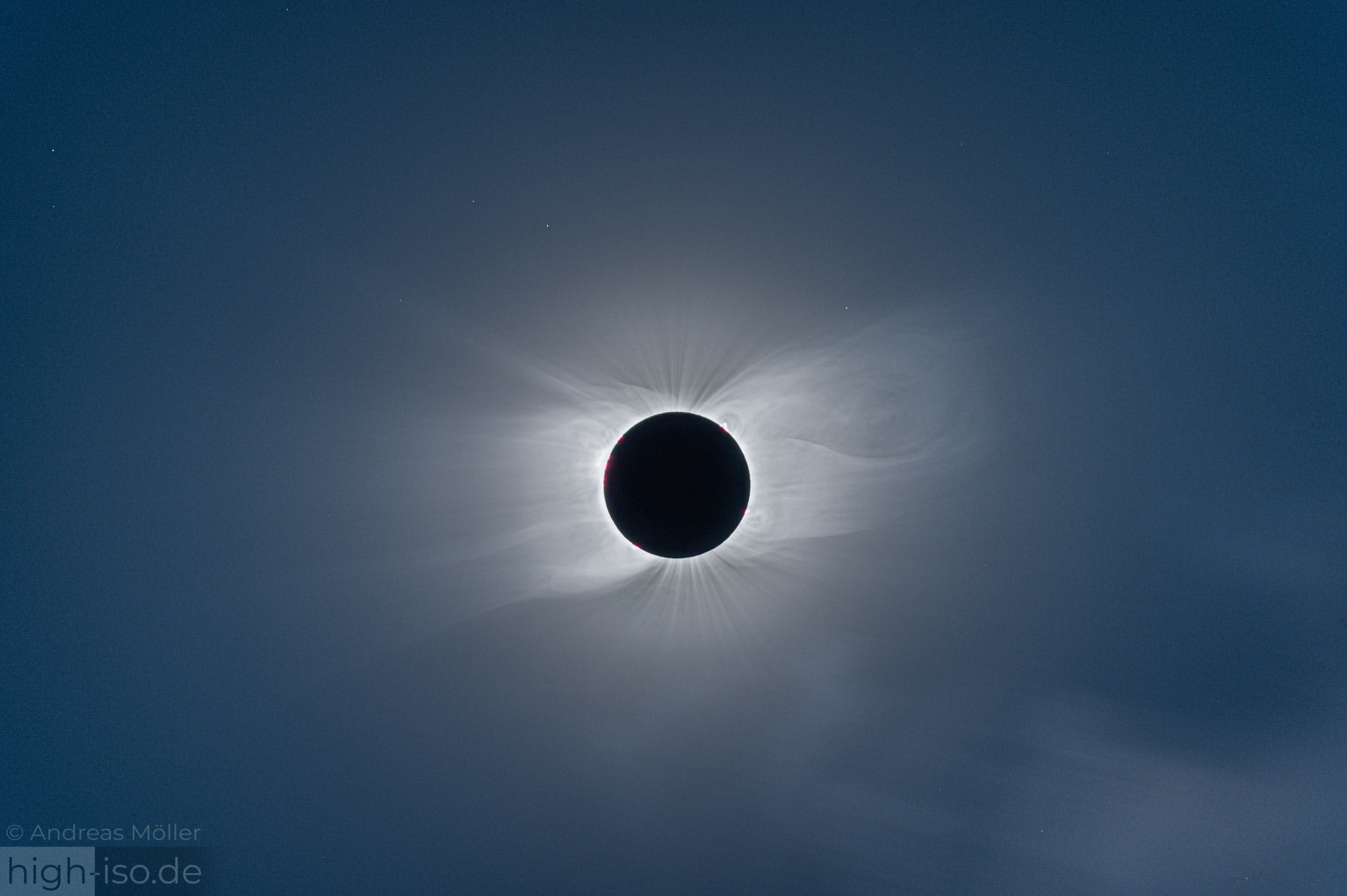
|
| |
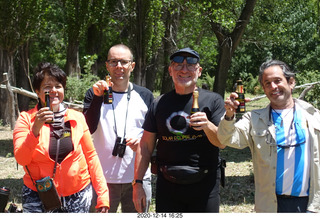 I have stories of previous eclipse
trips to
(1) Aruba,
(2) Hungary,
(3) Zambia,
(4) Australia,
(5) Libya,
(6) China,
(8) back to Australia,
(9) Uganda,
(11) Wyoming, and
(12) Argentina.
The third was on my own with a side trip to Victoria Falls,
the fifth combined Africa with the middle east
with plenty of stories to tell,
the seventh was a second trip to China without its own web page
(but with
pictures),
and
the tenth was a trip to south Asia also without its own web page
(but also with
pictures).
I have stories of previous eclipse
trips to
(1) Aruba,
(2) Hungary,
(3) Zambia,
(4) Australia,
(5) Libya,
(6) China,
(8) back to Australia,
(9) Uganda,
(11) Wyoming, and
(12) Argentina.
The third was on my own with a side trip to Victoria Falls,
the fifth combined Africa with the middle east
with plenty of stories to tell,
the seventh was a second trip to China without its own web page
(but with
pictures),
and
the tenth was a trip to south Asia also without its own web page
(but also with
pictures).
THE ECLIPSE ITSELF
What could be so wonderful and exciting that I would spend
Beethoven's 250th birthday without listening
to any of his music, live or recorded?
There is something deep and primal
about participating in an astronomical event
and seeing the sun in the sky go dark.
There are all kinds of testimonials out there
and nothing I can say here will add much to that.
So let's spend a few paragraphs going over
what happened and what I saw.
Here
is my earlier write-up on
"The Total Solar Eclipse Experience"
with a link to a more-scientific
page.
If you look at the myriad pictures of total solar eclipses,
they're often quite different,
kind of like the story of
six blind men and the elephant.
(The seventh blind man thought the elephant
was squishy and smelly.)
There are pictures with the ring of the white corona,
there are pictures with red prominences along a narrow ring of white,
and
there are pictures with long, white coronal streams.
There are pictures showing the moon's shadow along the ground
and
there are pictures showing its elongated darkness in the sky.
There are also enhanced pictures
showing the moon's face from reflected earthlight.
So much is happening on such a wide scale of size and brightness
that a single picture just doesn't do it.
(I'm told the reverse is true for the aurora borealis
where the pictures are bright and cheery
while the eye sees only a ghostly glow.
I'm told it's still worth going to see them,
but the camera captures more than the eye.)
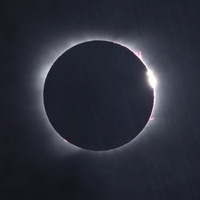 So we're all sitting around the eclipse site,
in this case a horse farm three hours drive southwest
of Neuquén, Argentina.
We're setting up our equipment to photograph the event.
Many have telescopes with various filters.
One buddy had a motorized drive to follow the sun
as the earth rotates,
a fancy-enough model to have an N-S switch
to go the other way for the Southern Hemisphere
where the sun and stars turn the other direction in the sky.
I set up my tripod and my Sony camera,
more than a point-and-shoot but less than a "real" camera.
My plan is to allow thirty seconds to take pictures
and then just to enjoy the experience of totality
with the image-stabilizing Canon binoculars
I bought for the eclipse in 1998 February.
We all got there early and waited anxiously
for the Big Event to begin.
So we're all sitting around the eclipse site,
in this case a horse farm three hours drive southwest
of Neuquén, Argentina.
We're setting up our equipment to photograph the event.
Many have telescopes with various filters.
One buddy had a motorized drive to follow the sun
as the earth rotates,
a fancy-enough model to have an N-S switch
to go the other way for the Southern Hemisphere
where the sun and stars turn the other direction in the sky.
I set up my tripod and my Sony camera,
more than a point-and-shoot but less than a "real" camera.
My plan is to allow thirty seconds to take pictures
and then just to enjoy the experience of totality
with the image-stabilizing Canon binoculars
I bought for the eclipse in 1998 February.
We all got there early and waited anxiously
for the Big Event to begin.
The wind was howling, gusts to 80 Km/h (45 knots),
so there was a chill in the air.
As I prepared for my usual pre-event run through the farmland,
some folks and I checked out the creek running through the woods.
On the other side, reachable by crossing a log,
was a clearing with a breeze instead of a gale,
apparently protected from the wind by tall trees.
We worked our way across with our equipment,
and set up our eclipse-watching paraphernalia over there.
Hay bales had been put in what became the the windy area
for our comfort and some nice people with stronger backs than mine
carried some of them across the stream for us to sit on.
I went for my run amid small horses and bigger trees
and returned to settle into my claimed square meter of pasture
between thorny plants and some manure
with my tripod and my own bale of hay.
The sky was almost entirely clear
which boded well for the upcoming celestial show
we were about to see.
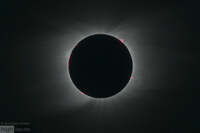 11:45 Argentina Standard Time (GMT-3, so it was 14:45 UTC).
Somebody yelled, "First contact!"
First Contact is when the invisible moon in the sky
first starts to cover the solar disk.
We looked through our solar-viewing glasses at the sun in the sky
and there was just the tiniest nick on the left side of the sun.
The excitement was building with this first observation.
11:45 Argentina Standard Time (GMT-3, so it was 14:45 UTC).
Somebody yelled, "First contact!"
First Contact is when the invisible moon in the sky
first starts to cover the solar disk.
We looked through our solar-viewing glasses at the sun in the sky
and there was just the tiniest nick on the left side of the sun.
The excitement was building with this first observation.
Looking at the sun with naked eye
on a normal clear day isn't a good idea
as it's really too bright to stare at for any length of time,
but eye damage isn't likely for a few seconds of solar viewing.
There will be a dark afterimage blocking one's vision for a while.
During an eclipse the danger of eye damage is far greater
because the normal clear day has been replaced
with a darkening sky and eyes becoming adapted for night vision.
Instead of a small pupil for daylight
we have wide-open pupils for maximum light gathering
and the fraction of sun still in the sky
is just as bright as during full daylight,
so the concentration of light on the retina
is seriously likely to do permanent damage.
The best plan is to keep the dark-eclipse glasses on
until totality.
Just to make it interesting,
the few moments before total coverage are spectacular
seen with naked eyes, no darkening glasses,
and picking the right moment to take them off comes
with experience and practice,
only possible from multiple eclipses.
For the first eclipse,
my advice is wait until others OOH and AAH,
and peek around to see if others are taking their glasses off
before taking your own glasses off.
You may miss a few of Baily's beads,
maybe even the first diamond ring,
but that's far better than missing the next episode
of "Law & Order" when you get home
because you can't see the television screen
from eclipse eye damage.
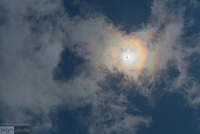 First Contact is entering the moon's shadow on the earth,
not the really-dark, narrow, cone-shaped umbra
but the partially-dark, wider penumbra
we've all seen in the eclipse-science pages.
Now that there is a chip in the sun,
we wait for an hour while nothing else interesting happens.
We're all excited, we fiddle with our cameras and telescopes,
we tell stories of other eclipses.
Some of us more professorial types tell eclipse newbies
about what is to come.
I had one fellow who had seen four eclipses
and heard reference to the four Contacts
without anybody explaining what they are,
so I gave him a brief science lecture.
One fellow had a white sheet spread out on the ground
to make shadow bands easier to see.
As the sun changes from a chipped disk to a crescent
in a gradually darkening sky,
some of us put our fingers in a criss-cross pattern
to cast shadows with crescent-shaped circles instead of round ones.
Some forward-planning soul has brought a
colander
which leaves myriad crescents in its shadow, very cool.
The darker daylight is creepy.
There isn't much else to do during that time.
First Contact is entering the moon's shadow on the earth,
not the really-dark, narrow, cone-shaped umbra
but the partially-dark, wider penumbra
we've all seen in the eclipse-science pages.
Now that there is a chip in the sun,
we wait for an hour while nothing else interesting happens.
We're all excited, we fiddle with our cameras and telescopes,
we tell stories of other eclipses.
Some of us more professorial types tell eclipse newbies
about what is to come.
I had one fellow who had seen four eclipses
and heard reference to the four Contacts
without anybody explaining what they are,
so I gave him a brief science lecture.
One fellow had a white sheet spread out on the ground
to make shadow bands easier to see.
As the sun changes from a chipped disk to a crescent
in a gradually darkening sky,
some of us put our fingers in a criss-cross pattern
to cast shadows with crescent-shaped circles instead of round ones.
Some forward-planning soul has brought a
colander
which leaves myriad crescents in its shadow, very cool.
The darker daylight is creepy.
There isn't much else to do during that time.
About four minutes before totality things get more interesting.
It's getting dark and cold fairly quickly.
Somebody pointed to the sky left of the sun and pointed out Venus,
now visible with less sunlight and blue sky to obscure it.
Shadows are getting very sharp as the sun
is now a thin, tiny crescent.
If you've ever seen a really dark night,
then you'll notice first that stars twinkle
and second that the twinkling goes in waves across the sky
as atmospheric waves of varying light refraction move by.
Well, the sun does the same thing.
It's too bright to notice it twinkling,
but the light on the ground often goes in light-dark waves,
not terribly lighter or darker,
hard to photograph or make a video,
but visibly happening.
We call this effect shadow bands.
In 2017 I was looking at the ground
for these shadow bands and my friend Kim pointed
out they were clearly visible on the white picnic table
in front of us.
This time, 2020, I was watching the white cloth
where I didn't see a damned thing happening
and somebody pointed out that shadow bands were visible
on the grass all around.
The moment is coming and things are happening fast by now.
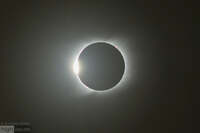 Some eclipse sites have a view of the surrounding countryside
and one can see the darkness of the
moon's shadow
approaching at two thousand miles per hour.
I've seen eclipses near sunset where
the north and south skies are much brighter
than the sky in the west.
(It was also probably dark in the east,
but I wasn't looking in that direction.)
Some eclipse sites have a view of the surrounding countryside
and one can see the darkness of the
moon's shadow
approaching at two thousand miles per hour.
I've seen eclipses near sunset where
the north and south skies are much brighter
than the sky in the west.
(It was also probably dark in the east,
but I wasn't looking in that direction.)
The crescent isn't perfect
as the surface of the moon
has hills and valleys, mountains and canyons,
all kinds of orography,
The effect of those craters, hills, and valleys
is the last bit of sun doesn't go away uniformly.
There are separate tiny bits and pieces of bright sun
called Baily's beads
as the corona becomes visible.
As the beads of sun disappear behind the body of the moon
there is often a final bright spot of sun with the corona
forming a diamond ring.
After a dozen total solar eclipses
I've developed a strategy for seeing the early beads and ring.
I'll look over or around my dark eclipse glasses
at a point in the sky not too far away from the sun
but not directly at it.
When I see a corona the glasses come off
and I usually get two or three beads
and the diamond ring before totality.
One lecturer explained it this way
for those less experienced to know when to look.
He said,
"Even if you don't know the game of American football,
you know when somebody scored a touchdown.
When everybody's cheering and yelling and `oohing and aahing,'
that's a good time to take the dark glasses off."
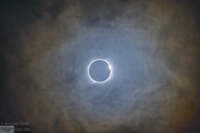 This eclipse had a thin cloud
between us and the sun at this point
which caused two interesting things to happen.
First,
there was a close-in rainbow around the
last bits of sun.
It looks yellow on some pictures,
I only got the slightest quick peek at it,
but I recall seeing rainbow colors for that fleeting glance.
Second,
there were shadow bands on the cloud itself.
I didn't see that at the actual eclipse time,
but they're clearly visible in photographs,
straight striations of light and dark in the cloud itself.
I've never seen anything like either of these
in my dozen other eclipses.
Andreas Moller's picture (on the right)
is a seriously-cool picture.
It's a great picture with the last bit of sun (Baily's beads)
and the prominences all appearing wonderfully well.
But there's a great deal more.
The cloud gives us a close-in circular rainbow around the sun
and the yellow part of that rainbow is visible in this picture.
Coolest and most amazing is that there are shadow bands
visible on the cloud itself.
This eclipse had a thin cloud
between us and the sun at this point
which caused two interesting things to happen.
First,
there was a close-in rainbow around the
last bits of sun.
It looks yellow on some pictures,
I only got the slightest quick peek at it,
but I recall seeing rainbow colors for that fleeting glance.
Second,
there were shadow bands on the cloud itself.
I didn't see that at the actual eclipse time,
but they're clearly visible in photographs,
straight striations of light and dark in the cloud itself.
I've never seen anything like either of these
in my dozen other eclipses.
Andreas Moller's picture (on the right)
is a seriously-cool picture.
It's a great picture with the last bit of sun (Baily's beads)
and the prominences all appearing wonderfully well.
But there's a great deal more.
The cloud gives us a close-in circular rainbow around the sun
and the yellow part of that rainbow is visible in this picture.
Coolest and most amazing is that there are shadow bands
visible on the cloud itself.
13:08 Argentina Standard Time.
The diamond fades and only the ring is left.
This is the moment when we enter
the moon's narrow, darker, cone-shaped umbra shadow.
We call that Second Contact.
The same side where the beads and diamond were a moment ago
is often still brighter red for a few seconds.
The inner ring of the sun's corona is brigher than the rest
and usually is populated with prominences,
small, brighter red arcs on the surface of the sun.
I took a few pictures with my relatively pitiful camera setup
for twenty or thirty seconds and then just watched the show
in the sky.
While naked eyes can resolve them as more than just red dots
I recommend using binoculars.
When I couldn't keep my binoculars steady enough
for the image stabilization to kick in
while I was standing up,
I lay myself down on the nearest bale of hay
to look straight up at the sun.
This time there were major prominences
at two, four, and seven o'clock on the face of the sun
with some reddish activity around ten and eleven o'clock.
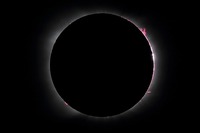 I'll point out that those little, red prominences
on the outside of the sun aren't so little.
They're generally bigger than our own planet.
They look small because the sun is huge,
about one hundred times larger than the Earth.
I'll point out that those little, red prominences
on the outside of the sun aren't so little.
They're generally bigger than our own planet.
They look small because the sun is huge,
about one hundred times larger than the Earth.
I've seen planets at solar eclipses but almost never stars.
Part of eclipse lore is a test of
Albert Einstein's Theory of General Relativity.
He predicted light would bend more in a gravitational field
than previous physics theory.
The sun has a really intense gravitational field
so stars appear further away from it as their light is bent.
Stars are completely invisible during normal sunny daylight,
but can be photographed during a total solar eclipse.
With a long-enough exposure, the camera can photographs stars
during the eclipse even if our naked eyes can't see them.
As I recall,
they used the exact same camera six months before the eclipse
and then during the eclipse on
1919 May 29
and the difference of spacing between stars
confirmed Einstein's version of physics.
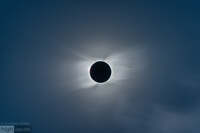 Another story is about an eclipse on
1973 June 30
where a prototype Concorde 001 was able to fly
in the moon's umbra for seventy-four minutes.
The airplane was modified with a clear view on top.
At the Uganda eclipse I met
one
of the
scientists
on that flight.
It was the perfect situation.
The moon goes 2200 miles per hour around the earth,
at the equator the earth rotates at 1047 miles per hour,
this was a seven-minute eclipse with a large umbral shadow,
so the airplane could fly in that shadow for nearly
seventy-four minutes.
Another story is about an eclipse on
1973 June 30
where a prototype Concorde 001 was able to fly
in the moon's umbra for seventy-four minutes.
The airplane was modified with a clear view on top.
At the Uganda eclipse I met
one
of the
scientists
on that flight.
It was the perfect situation.
The moon goes 2200 miles per hour around the earth,
at the equator the earth rotates at 1047 miles per hour,
this was a seven-minute eclipse with a large umbral shadow,
so the airplane could fly in that shadow for nearly
seventy-four minutes.
The earth's orbit is elliptical so
the size of the sun in the sky varies.
The moon's orbit is similarly elliptical
so the size of the moon in the sky varies.
The ecliptic
is the plane of the earth's orbit around the sun.
The earth's rotation is at a 23½° to the ecliptic
which is where the seasons come from.
The moon's orbit is at a five-degree angle to the ecliptic
so the moon is in the ecliptic plane about twice a year
and only then will its shadow fall on the earth.
When the moon is far and the sun is close
we get a ring-of-sun called an annular eclipse.
("Anulus" is Latin for a small ring.)
When the moon is close and the sun is far
we get a total eclipse, the kind worth traveling for.
Total eclipses happen about twice every three years.
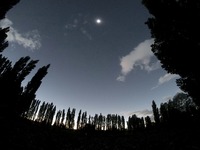 Eclipses are
periodic
in various ways.
The most common period used is the saros which is
eighteen years, eleven days, and eight hours.
It is an even multiple
of the synodic month
(new moon to new moon),
anomalistic month
(moon perigee to moon perigee), and
draconic month
(node to node, the tilt of the moon's orbit around the earth
relative to the earth's orbit around the sun where
a node is the moon being in the ecliptic plane).
My first nine total solar eclipse were in nine different
saroi
and the last four were in the same saroi as the first four.
Because the three month-intervals don't exactly match,
a saros lasts twelve to fifteen centuries
before its umbra no longer lands on the earth.
An inex is twenty days less than twenty-nine years
with only the synodic and draconic months
and typically lasts 225 centuries
as the match of just the two periods is far closer.
Unlike the consistency of saros eclipses,
inex eclipses vary in length and type.
Eclipses are
periodic
in various ways.
The most common period used is the saros which is
eighteen years, eleven days, and eight hours.
It is an even multiple
of the synodic month
(new moon to new moon),
anomalistic month
(moon perigee to moon perigee), and
draconic month
(node to node, the tilt of the moon's orbit around the earth
relative to the earth's orbit around the sun where
a node is the moon being in the ecliptic plane).
My first nine total solar eclipse were in nine different
saroi
and the last four were in the same saroi as the first four.
Because the three month-intervals don't exactly match,
a saros lasts twelve to fifteen centuries
before its umbra no longer lands on the earth.
An inex is twenty days less than twenty-nine years
with only the synodic and draconic months
and typically lasts 225 centuries
as the match of just the two periods is far closer.
Unlike the consistency of saros eclipses,
inex eclipses vary in length and type.
The range of light in a total solar eclipse
makes it difficult to photograph.
Photographers measure light in f-stops
where each f-stop is a factor of two in total light.
Astronomers measure light in magnitudes,
factors of 2.5 so five magnitudes make a factor of one hundred.
(It's more offbeat, but signal-processing weenies
use decibels (dB) where each decibel
is a factor of 1.26 so 10 dB is a factor of ten.)
I think the main-sun photosphere is about
104 times brigher than the inner corona
(thirteen stops)
which is about 103 times brighter
than the outer corona.
So a clear-sky, no-clouds picture of the diamond ring
has to cover twenty-three stops from lightest to darkest,
eighteen-magnitudes, 70 dB.
The only hope of getting that from a camera
is take lots of pictures with varying exposure
and combine them with some kind of image-superposition software.
In total brightness, they tell me the corona
is about as bright as a full moon.
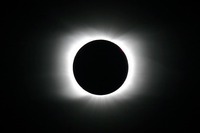 While these eclipse-lore stories and science
may be interesting reading in my eclipse travelogue
between Second Contact and Third Contact,
none of that was on my mind in the two minutes of totality
on 2020 December 14.
I was looking eagerly skyward to see as much as
I could in a short time.
The thin cloud blew away and we all had
a totally-unobstructed view of totality.
I looked through my binoculars at the surface of the sun
and its three major prominences,
I put down the binoculars and looked at the four planets
Venus, Mercury, Jupiter, and Saturn in the sky,
then back to the sun's corona.
This eclipse had coronal streamers east and west
with less north and south.
While these eclipse-lore stories and science
may be interesting reading in my eclipse travelogue
between Second Contact and Third Contact,
none of that was on my mind in the two minutes of totality
on 2020 December 14.
I was looking eagerly skyward to see as much as
I could in a short time.
The thin cloud blew away and we all had
a totally-unobstructed view of totality.
I looked through my binoculars at the surface of the sun
and its three major prominences,
I put down the binoculars and looked at the four planets
Venus, Mercury, Jupiter, and Saturn in the sky,
then back to the sun's corona.
This eclipse had coronal streamers east and west
with less north and south.
This is a magic, special, wonderful time,
at least for those of us who make these
total-solar-eclipse journeys.
Maybe somehow we're participating in something
of astronomical, cosmic scale in the solar system,
maybe it's the connection with total solar eclipses in history,
or maybe it's just the coolness of
watching the sun go out and seeing the corona,
but there is magic in the moment.
13:10 Argentina Standard Time.
The other side of the sun has been getting brighter,
ruby red and getting whiter,
and a spark of brilliant white sun appears
to form another diamond ring
for Third Contact.
A few beads appear, the corona fades in the brightening sky,
and this is a very good time to look away from the sun.
Any further viewing should be done through dark eclipse glasses.
Sometimes we see shadow bands again.
By this time the cloud and its cool effects were gone.
Third Contact is the umbra leaving us
and we're back in the penumbra.
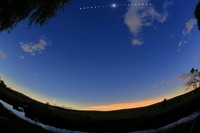 A few minutes after Third Contact
things are pretty dull again.
It's like the time between
First Contact and just before Second Contact
without the eager anticipation of the Big Event.
Some people go away, the thrill is over,
and others hang out to the bitter end.
Maybe it's some kind of principle,
I came for an eclipse and I'm going to see the whole thing.
As before, we're putting our dark glasses on from time to time
and peeking at the now-growing crescent sun.
The lighting is coming back to normal daytime.
A few minutes after Third Contact
things are pretty dull again.
It's like the time between
First Contact and just before Second Contact
without the eager anticipation of the Big Event.
Some people go away, the thrill is over,
and others hang out to the bitter end.
Maybe it's some kind of principle,
I came for an eclipse and I'm going to see the whole thing.
As before, we're putting our dark glasses on from time to time
and peeking at the now-growing crescent sun.
The lighting is coming back to normal daytime.
14:36 Argentina Standard Time.
The last bit of penumbra leaves us at
Fourth Contact and we see
the last chip on the rim of the sun go away.
Eclipse time is over and done.
Those who haven't packed up their
cameras, tripods, and telescopes
get busy putting their stuff away.
Some really-nice folks built a little wooden bridge
across the creek,
so I didn't have to make my way back across the log.
We made our way back to the bus with our stuff,
took an Astro-Trails group photo,
and took the three-hour drive back to Neuquén.
The final stage of most of my total solar eclipses
is yet another corona.
This final corona is a bottle of Corona beer.
A new eclipse friend on this trip
had an interesting
keepsake, a
tiny
piece of the Apollo 11 spacecraft.
It had been in the moon's shadow thirty-one times
in the mission trajectory and in orbit around the moon.
Now it has been in the moon's shadow two more times.
For five of my eleven land-based eclipses
I slept in the eclipse path so I didn't have to travel
on eclipse day.
For the other two I was on a cruise ship for eclipse viewing.
On 2002 December 4 we drove
from the base in Woomera, Australia to our viewing site,
but I recall the base itself was still
in the umbral-shadow path of totality.
BEFORE THE JOURNEY
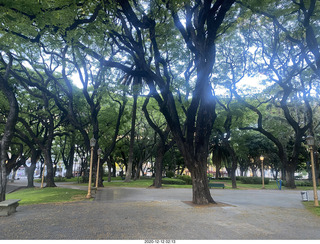 I had had three total-solar-eclipse trips
with London-based Explorers
and three more with the same tour leaders as Astro Trails,
also out of London.
I was deliriously happy with them all six times
and made my plans with them before
the corona virus and any of
the COVID-19 panic and restrictions.
Many countries have been restricting entry,
"closed borders,"
and others require a two-week quarantine upon entry,
or re-entry.
Many tour companies canceled
all their travel plans for 2020 December.
Argentina and Chile have been especially resistant
to having intercontinental visitors.
It makes planning an eclipse tour difficult and
the shadow of the moon doesn't make changes in its path
to accommodate border closures or other political pressures.
The usual myriad tour options were trimmed to two short ones
with different hotels in Pategonia,
a week in duration.
(I think that was the only difference
between Tour 1 and Tour 2.)
I had had three total-solar-eclipse trips
with London-based Explorers
and three more with the same tour leaders as Astro Trails,
also out of London.
I was deliriously happy with them all six times
and made my plans with them before
the corona virus and any of
the COVID-19 panic and restrictions.
Many countries have been restricting entry,
"closed borders,"
and others require a two-week quarantine upon entry,
or re-entry.
Many tour companies canceled
all their travel plans for 2020 December.
Argentina and Chile have been especially resistant
to having intercontinental visitors.
It makes planning an eclipse tour difficult and
the shadow of the moon doesn't make changes in its path
to accommodate border closures or other political pressures.
The usual myriad tour options were trimmed to two short ones
with different hotels in Pategonia,
a week in duration.
(I think that was the only difference
between Tour 1 and Tour 2.)
With England and Canada requiring self-quarantine for two weeks
upon re-entry,
my eclipse friends from those countries
canceled their Astro Trails travel.
My usual eclipse travel companion is older
and having respiratory-health issues.
A pulmonary corona virus
that made me need an extra hour of sleep for a week
would likely do my friend serious harm.
As he doesn't carry a cell phone,
he has a difficult time managing documents and arranging tests.
With great regrets he "bailed" at the last minute,
a wise decision in my opinion.
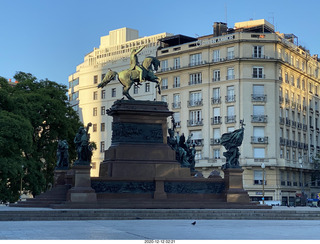 Brian McGee is a great negotiator.
If there's a "win-win" solution, then he finds a way to get it.
Argentina has been closed since 2020 March,
they would benefit greatly having tourists,
but they don't want their people getting sick
catching a bug from visitors.
We really wanted to be in Patagonia 2020 December 14
and a month later doesn't work for us.
Tourists aren't going to appreciate two weeks of quarantine.
I would have canceled my trip if it took fourteen days
stuck in a hotel room before I could travel in Argentina.
Brian McGee is a great negotiator.
If there's a "win-win" solution, then he finds a way to get it.
Argentina has been closed since 2020 March,
they would benefit greatly having tourists,
but they don't want their people getting sick
catching a bug from visitors.
We really wanted to be in Patagonia 2020 December 14
and a month later doesn't work for us.
Tourists aren't going to appreciate two weeks of quarantine.
I would have canceled my trip if it took fourteen days
stuck in a hotel room before I could travel in Argentina.
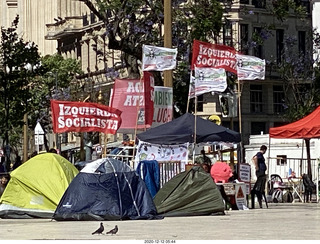 So here's the new deal between Astro Trails and Argentina.
We keep track of our medical history and take our temperature
every day for two weeks before entry,
we provide various documents and declarations,
and we provide negative test results
of a COVID-19 PCR way-up-the-nose test
within 72 hours before entering Argentina.
What's tight is the test results have to be in London,
email is allowed,
the day before we start our tour,
so the actual window for the test is tight.
The legal window was Tuesday 9:53 Argentinian Standard Time (GMT-3)
through Thursday 12:00 Greenwich Mean Time (GMT).
That's Tuesday 5:53 to Thursday 5:00 (all in the morning).
Labs open at 8:00 and close at dinnertime, so that leaves
a window of about thirty-two hours.
I took three PCR tests,
all came back in time,
and all were negative.
The online declaration had some questions that raised questions
and there were oodles of helpful, explanatory emails from
Astro Trails in London.
So here's the new deal between Astro Trails and Argentina.
We keep track of our medical history and take our temperature
every day for two weeks before entry,
we provide various documents and declarations,
and we provide negative test results
of a COVID-19 PCR way-up-the-nose test
within 72 hours before entering Argentina.
What's tight is the test results have to be in London,
email is allowed,
the day before we start our tour,
so the actual window for the test is tight.
The legal window was Tuesday 9:53 Argentinian Standard Time (GMT-3)
through Thursday 12:00 Greenwich Mean Time (GMT).
That's Tuesday 5:53 to Thursday 5:00 (all in the morning).
Labs open at 8:00 and close at dinnertime, so that leaves
a window of about thirty-two hours.
I took three PCR tests,
all came back in time,
and all were negative.
The online declaration had some questions that raised questions
and there were oodles of helpful, explanatory emails from
Astro Trails in London.
Several weeks before my trip
I saw Dr. Bryant,
my travel doctor at the Mayo Clinic
where I got my flu shot.
After last trip's cute coatis bit some of my travel mates
at Iguazu Falls
I figured I'd better get my rabies booster.
Dengue and Zika are carried by mosquitoes
which are becoming more active as summer is approaching.
I decided to book my flights with the travel agent
working with Astro Trails so everything
would be coordinated.
THE JOURNEY THERE
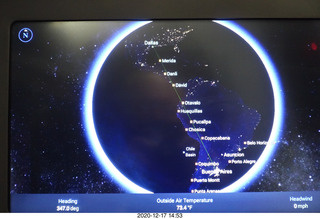 I left Phoenix (PHX)
2020 December 10, Thursday afternoon.
While at the gate in Dallas (DFW) that evening
I got an email with some document I might have
to show the gate agent on my cell phone,
which I believe I recall doing.
Several eclipse buddies were on the same
ten-hour, overnight flight to Buenos Aires (EZE)
and Astro Trails had a representative waiting outside
the airport gathering us up and getting us on a bus
to the hotel on Friday morning.
Face masks were required just about everywhere.
For this trip I was masked except
in my hotel room, eating, drinking, running,
or outside at the breezy eclipse site.
We got our temperatures taken anytime entering a hotel or bus
and service people were generous with disinfecting hand spray.
Our first night in the Marriott/Sheraton hotel
we got COVID-19 PCR tests to confirm our uninfected status
and all of them returned desirable negative results.
I left Phoenix (PHX)
2020 December 10, Thursday afternoon.
While at the gate in Dallas (DFW) that evening
I got an email with some document I might have
to show the gate agent on my cell phone,
which I believe I recall doing.
Several eclipse buddies were on the same
ten-hour, overnight flight to Buenos Aires (EZE)
and Astro Trails had a representative waiting outside
the airport gathering us up and getting us on a bus
to the hotel on Friday morning.
Face masks were required just about everywhere.
For this trip I was masked except
in my hotel room, eating, drinking, running,
or outside at the breezy eclipse site.
We got our temperatures taken anytime entering a hotel or bus
and service people were generous with disinfecting hand spray.
Our first night in the Marriott/Sheraton hotel
we got COVID-19 PCR tests to confirm our uninfected status
and all of them returned desirable negative results.
I don't know what geological, astronomical,
and cartographical expert
designed the in-flight maps for American Airlines.
The DFW-EZE leg on the globe repeatedly reports 10603 miles.
The actual air distance is 5285 miles, or so Google says.
Well, maybe it's just kilometers represented as miles,
but the air distance is 8500 Km, far short of 10603.
The moving-map display is fantastic with interesting perspectives
and lots of detailed views,
but whoever computed those distances for the display
seems quite misguided.
The same global-view distance for DFW-PHX is 1731 miles.
The actual distance is 868 miles, 1389 Km,
nowhere near 1731 of anything.
I trust the pilots in the cockpit have their own
estimates of distance.
ARGENTINA
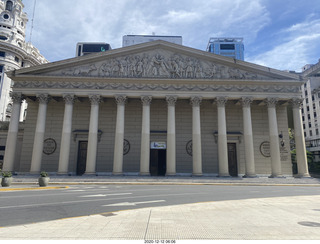 There is a nice little park across the street from the hotel
where I took my running exercise
and some great shopping just past the park
on Florida Street.
Walking along Florida Street there are a lot of people
muttering "cambio, cambio" for money changing
at a substantially better rate than the banks offer.
They especially like United States $50 and $100 bills.
Given the roughly 100 tourists for this eclipse
are the first intercontinental visitors since 2020 March,
it seems there are more money changes on Florida Street
than there are tourists who might change money.
There is a nice little park across the street from the hotel
where I took my running exercise
and some great shopping just past the park
on Florida Street.
Walking along Florida Street there are a lot of people
muttering "cambio, cambio" for money changing
at a substantially better rate than the banks offer.
They especially like United States $50 and $100 bills.
Given the roughly 100 tourists for this eclipse
are the first intercontinental visitors since 2020 March,
it seems there are more money changes on Florida Street
than there are tourists who might change money.
Brian McGee and his staff
not only wangled our entry into Argentina,
he got us a tour of Buenos Aires
on 2020 December 12, Saturday,
where we saw sites all over the city
and ate a fantastic steak lunch.
(I didn't ask what they served vegetarians.)
This tour filled in the gap in the 2019 tour package.
We got full-day tours all over
capital cities Rio de Janeiro, Santiago, and Lima
and a lot of interesting other places,
Buenos Aires was a one-night stay
with a delightful evening of dining and tango,
but we saw none of the city itself.
So now, a year and a half later,
we got to see Buenos Aires with a real tour.
Our Sunday flight
to Neuquén was pleasant enough.
There was a weight restriction on luggage
on these domestic flights within Argentina.
I didn't have a problem as I just left some stuff
at the Marriott/Sheraton hotel where we were coming back
in a few days,
but those with larger telescopes and cameras
had to find a way to get under 15 Kg
for their
checked luggage.
Our tour leaders tried to get the airline to accept
us as a group so we could get our average under 15 Kg,
I don't think they were successful,
but I didn't hear of anybody having a problem.
We stayed in a Howard Johnson's hotel,
a brand we have not seen in the United States
for several decades.
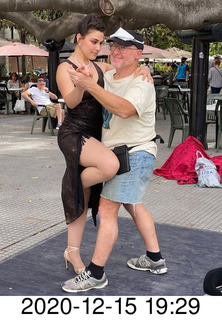 I had enough time for a run on Sunday afternoon
on a dirt road along along the railroad tracks.
A few of us planned to get up extra early on Monday
so we could do some star gazing before dawn,
maybe even see some of the Geminid meteor shower.
The pre-dawn sky was cloudy
and we ended up enjoying hotel-lobby breakfast instead.
Then we had the three-hour bus ride to the eclipse site.
I had enough time for a run on Sunday afternoon
on a dirt road along along the railroad tracks.
A few of us planned to get up extra early on Monday
so we could do some star gazing before dawn,
maybe even see some of the Geminid meteor shower.
The pre-dawn sky was cloudy
and we ended up enjoying hotel-lobby breakfast instead.
Then we had the three-hour bus ride to the eclipse site.
The eclipse was terrific.
See the first chapter of this
travelogue for details.
Our evening bus ride back was relaxing,
sleep time for most of us,
and the start of our multi-stage trip home.
2020 December 15, Tuesday,
was our flight back to Buenos Aires,
the one with the especially-low weight limits for luggage.
After we got back to the Sheraton/Marriott hotel,
I got my extra luggage back from the hotel.
As I'm still the math-computer-algorithm geek
for our retail-science software,
some work from my company came my way
last Friday and this Tuesday.
I was lucky to be on this hotel's really-strong Wifi network.
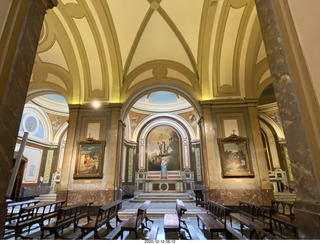 2020 December 15, Tuesday evening,
the Astro-Trails group decided to go out to
someplace nice for dinner and we all paid for our
Astro-Trails host's dinner.
It was a joyful, pleasant, fun time.
2020 December 15, Tuesday evening,
the Astro-Trails group decided to go out to
someplace nice for dinner and we all paid for our
Astro-Trails host's dinner.
It was a joyful, pleasant, fun time.
I did my morning run in the now-familiar park nearby
and joined some of my new eclipse friends for breakfast.
It was a pleasant stroll to the President's pink house plaza
where we had dined a few days earlier.
As I did some work and happened to be sitting around
my hotel at the time of our morning meeting,
afternoon Argentina time,
I joined the meeting via the Internet as usual
except that the backdrop behind me was a hotel room
instead of my house.
THE JOURNEY HOME
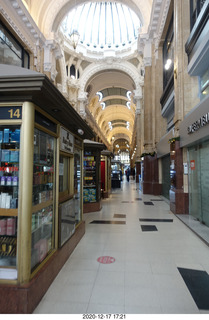 Just before that bus arrived,
we got emails that there was another declaration form needed
to leave Argentina.
There were some tricks we figured out to fill it out
and then there was the battle of printing it
by emailing it to the hotel and having them print it.
Of course it was a hassle,
the printout didn't appear,
they didn't get the email,
my laptop didn't get back on their wireless,
my friend's laptop didn't log onto my email,
I had a mild panic attack,
I ultimately got the form printed,
and the folks at the airport never asked for it.
Just before that bus arrived,
we got emails that there was another declaration form needed
to leave Argentina.
There were some tricks we figured out to fill it out
and then there was the battle of printing it
by emailing it to the hotel and having them print it.
Of course it was a hassle,
the printout didn't appear,
they didn't get the email,
my laptop didn't get back on their wireless,
my friend's laptop didn't log onto my email,
I had a mild panic attack,
I ultimately got the form printed,
and the folks at the airport never asked for it.
There was no trouble getting on the flight
back to the United States,
the eleven-hour, overnight flight itself was pleasant,
and I got to use my Global Entry (GOES) membership
to get into the United States.
We don't fill out the old I-94 entry forms anymore.
There were specific machines for GOES
with facial recognition so I didn't need
my paper passport to get back into the United States.
My friend picked me up at the airport,
I got home 2020 December 17, Thursday, mid-day,
and found my home and cats wonderfully cared for
in my absence.
AFTER THE JOURNEY
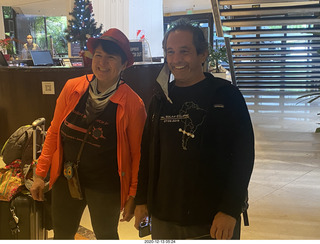 This was definitely an abbreviated trip,
appropriate given the COVID-19 border issues.
The trip was travel south,
a tour of Buenos Aires,
more travel south,
an eclipse,
and travel north all the way back home.
Is it worth all that for
2:06 (two minutes and six seconds)
of solar-eclipse totality?
We could ask that for any total-solar-eclipse tour,
like a trip to Uganda for eighteen seconds
seen through a layer of clouds,
but this was a lot of paperwork hassle and travel
with very little other than the eclipse.
Well, that's part of the COVID-19 experience,
others have had a lot worse consequences from this disease,
and Astro Trails did a magnificent job of handling it all.
Other people sing "Me and You and a Dog Name Blue"
while I'm singing "You and Me and Brian McGee."
This was definitely an abbreviated trip,
appropriate given the COVID-19 border issues.
The trip was travel south,
a tour of Buenos Aires,
more travel south,
an eclipse,
and travel north all the way back home.
Is it worth all that for
2:06 (two minutes and six seconds)
of solar-eclipse totality?
We could ask that for any total-solar-eclipse tour,
like a trip to Uganda for eighteen seconds
seen through a layer of clouds,
but this was a lot of paperwork hassle and travel
with very little other than the eclipse.
Well, that's part of the COVID-19 experience,
others have had a lot worse consequences from this disease,
and Astro Trails did a magnificent job of handling it all.
Other people sing "Me and You and a Dog Name Blue"
while I'm singing "You and Me and Brian McGee."
I had a great time.
Really.
Travel was pleasant enough,
Astro Trails was terrific,
it was good to see Brian McGee one more time,
and I made some new eclipse friends.
(I was even able to get some work done.
One of the consequences of COVID-19 is
more Internet infrastructure making it easier
to be in touch with my colleagues than it was
on earlier total-solar-eclipse trips.)
The next two are challenging,
2021 December 4 in Antarctica
and
2023 April 20 between Asia and Australia.
After that is 2024 April 8
right here in the U.S. of A.
This was eclipse Lucky Thirteen for me.
It was great, it was wonderful, maybe the best I've seen.
In any case, the total solar eclipse was,
once again,
a deep and fulfilling experience.
_
THE ADAM HOME PAGE
adam@the-adam.com
 This is the story of my thirteenth total solar eclipse,
a brief travel adventure back to Argentina.
I expected to come home with
pictures
and a few adventure stories.
This is my seventh trip with Brian McGee's companies,
Explorers and then Astro Trails,
and the seventh time I have been deliriously happy
with the results.
Mike was our guide for Tour 1
and I was deliriously happy with his efforts as well.
This is the story of my thirteenth total solar eclipse,
a brief travel adventure back to Argentina.
I expected to come home with
pictures
and a few adventure stories.
This is my seventh trip with Brian McGee's companies,
Explorers and then Astro Trails,
and the seventh time I have been deliriously happy
with the results.
Mike was our guide for Tour 1
and I was deliriously happy with his efforts as well.


 I have stories of previous eclipse
trips to
(1) Aruba,
(2) Hungary,
(3) Zambia,
(4) Australia,
(5) Libya,
(6) China,
(8) back to Australia,
(9) Uganda,
(11) Wyoming, and
(12) Argentina.
The third was on my own with a side trip to Victoria Falls,
the fifth combined Africa with the middle east
with plenty of stories to tell,
the seventh was a second trip to China without its own web page
(but with
pictures),
and
the tenth was a trip to south Asia also without its own web page
(but also with
pictures).
I have stories of previous eclipse
trips to
(1) Aruba,
(2) Hungary,
(3) Zambia,
(4) Australia,
(5) Libya,
(6) China,
(8) back to Australia,
(9) Uganda,
(11) Wyoming, and
(12) Argentina.
The third was on my own with a side trip to Victoria Falls,
the fifth combined Africa with the middle east
with plenty of stories to tell,
the seventh was a second trip to China without its own web page
(but with
pictures),
and
the tenth was a trip to south Asia also without its own web page
(but also with
pictures).


















